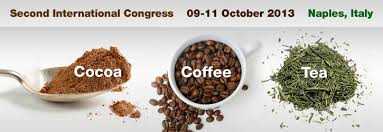Kroyer G., Zakaria M.Institute of Chemical Engineering, Division of Plant and Food Sciences, University of Technology, Vienna, Austria E-mail: gerhard.kroyer@tuwien.ac.at There is a growing interest in the food industry and in preventive health care in the evaluation of natural antioxidants from plant materials.
Coffee is one of the most popular beverages and consumed worldwide every day. Beside caffeine as bioactive ingredient of coffee other nutritional-physiological active compounds may contribute to the valuable properties of coffee beverages.
Coffee has been identified as a rich source of dietary polyphenols which gained much interest recently due to its antioxidant capacity and its health benefits with a major focus on degenerative diseases.
In this study, green and roasted coffee beans from different origins (Coffea Arabica from Nicaragua, Brazil and Ethiopia and Coffea Robusta from Ecuador) which was obtained directly from local producers as well as coffee beverages prepared thereof by commonly used procedures as espresso and filter coffee were analyzed in regard to its content of polyphenol compounds and antioxidant properties.
Extracts of green and roasted coffee beans were prepared with 60 % aqueous methanol and the filter and espresso coffee beverages were analyzed directly.
The content of total polyphenols was determined using the Folin-Ciocalteu assay. Antioxidant activities were determined with the DPPH* radical scavenging method as well as with the ABTS-radical assay in terms of their Trolox Equivalent Antioxidant Capacity TEAC.
In the different coffee beans the content of total polyphenols was determined in the range of 39,6 to 55,8 mg/g with the highest amounts in Robusta coffee beans from Ecuador followed by the Arabicas in the order Ethiopia, Nicaragua and Brazil which had only slight variations in their polyphenol content.
The content of polyphenols in roasted coffee beans was throughout slightly diminished compared with the green coffee beans. The same trend in regard to region-related differences in the polyphenol content was observed with the corresponding coffee beverages with generally higher amounts in espresso (32,6 – 39,7 mg/g) than in filter coffee (26,4 – 29,2).
All the coffee beans and coffee beverages possessed high antioxidant capacity in the same order and in correlation to the content of polyphenol compounds with TEAC-values of 0,15 – 0,41 mmol TE/g. In conclusion the highest antioxidant activity was observed in Robusta from Ecuador, green coffee beans showed higher activity than roasted coffee beans and espresso better radical scavenging activity than filter coffee.
The results of this study indicate that coffee beverages have high antioxidant and radical scavenging properties in correlation with the content of polyphenol substances and are a major source of dietary antioxidants.
As functional beverage consumption of coffee may offer a potential beneficial impact to human health.
















